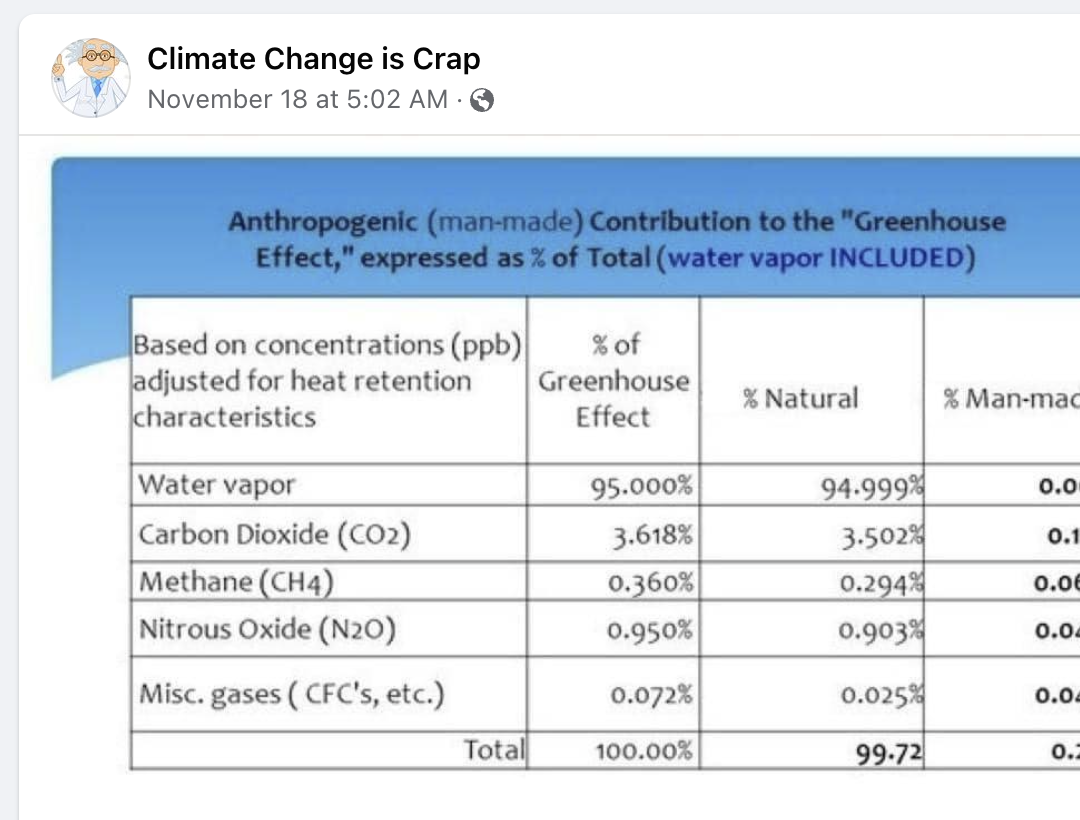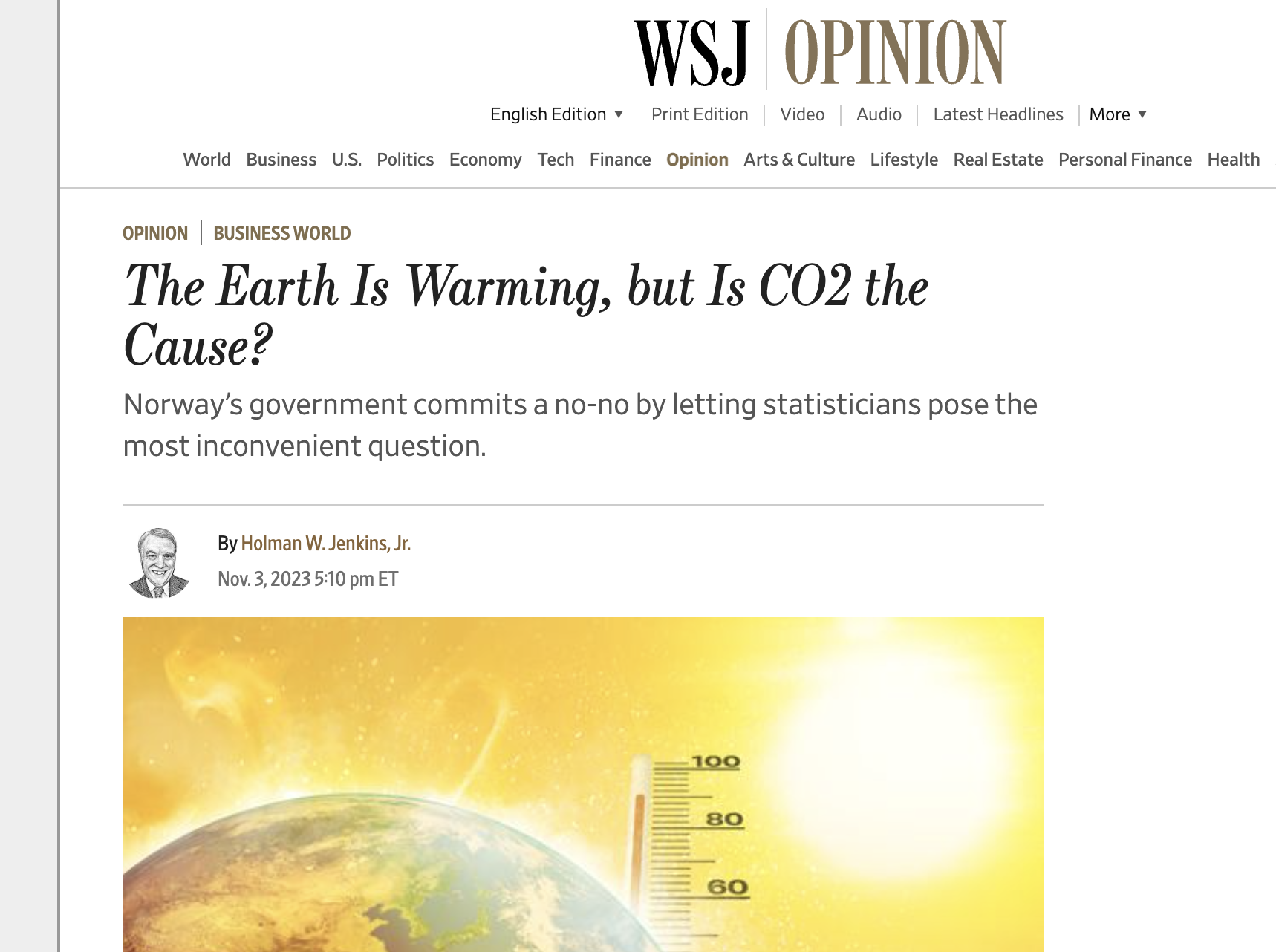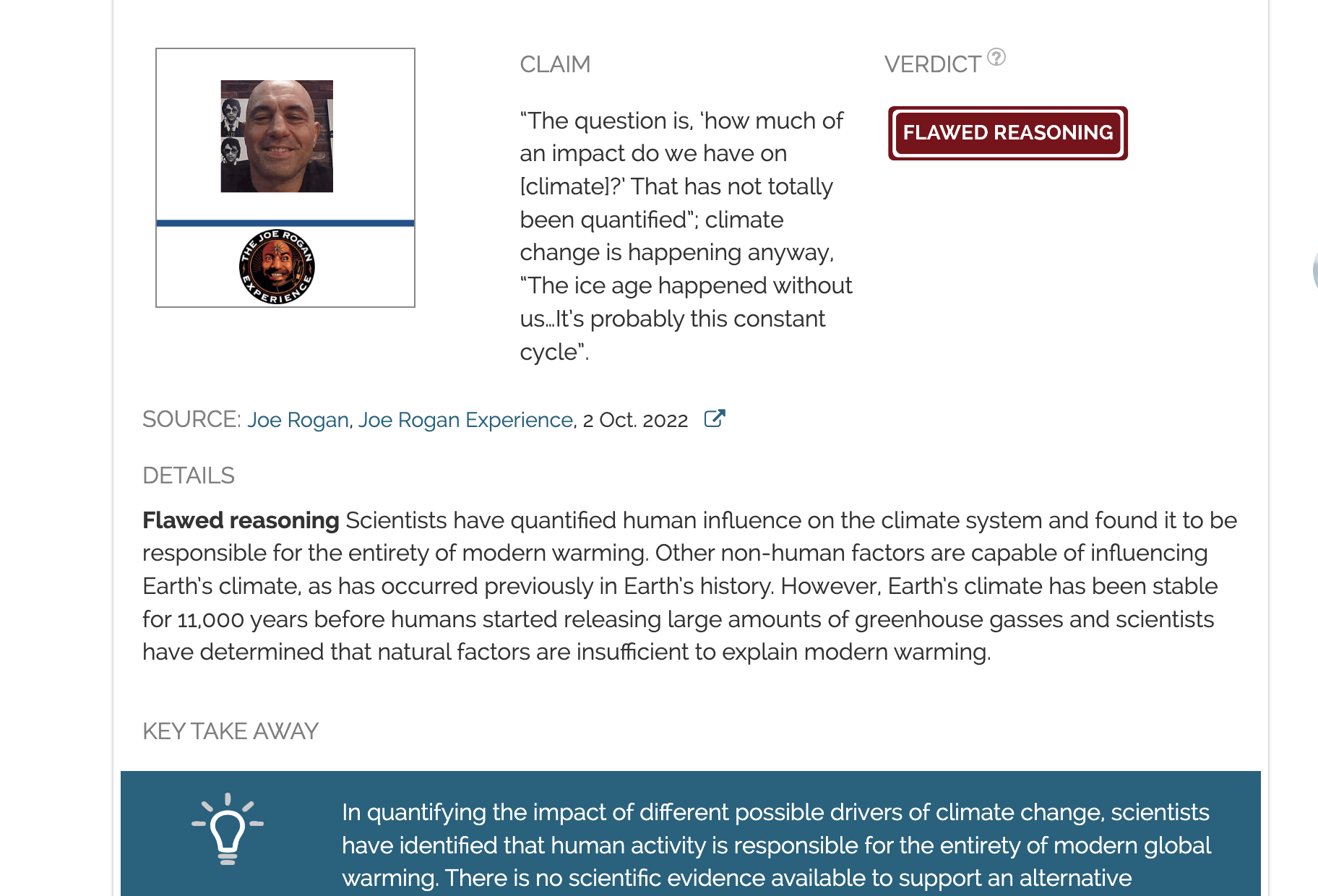- Climate
Letter signed by "500 scientists" relies on inaccurate claims about climate science
Reviewed content
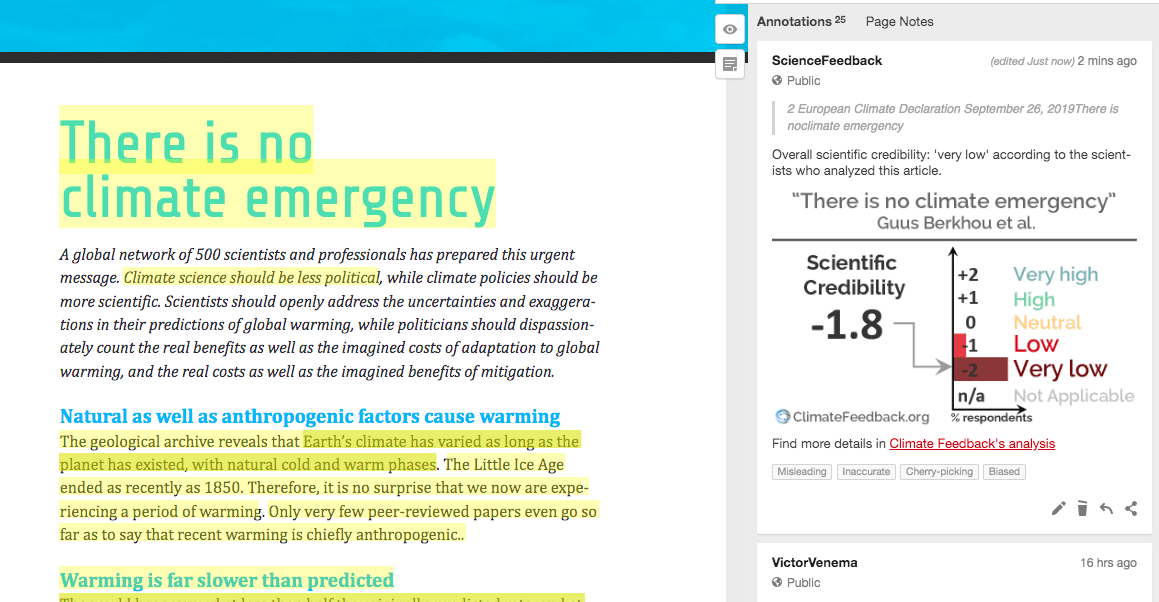
Headline: "There is no climate emergency"
Published in Clintel, by Reynald du Berger, Benoit Rittaud, Richard Lindzen, Christopher Monckton, Rob Lemeire, Fritz Vahrenholt, Terry Dunleavy, Guus Berkhout, Ingemar Nordin, Jeffrey Fos, Viv Forbes, Jim O'Brien, Alberto Prestininzi, Morten Jodal, on 2019-09-23.

Scientists’ Feedback
SUMMARY
This letter presenting a short list of claims about climate change boasts a list of “500 scientists and professionals” who have co-signed it.
The claims contradict or misrepresent the evidence uncovered by geoscientists, failing to provide support for its conclusions downplaying the threat of climate change. The letter claims, for example, that climate models ignore the benefits of increased CO2 on plant growth. This is false, as many climate models simulate the response of vegetation to increased CO2—and the climate change it causes.
And while some outlets described the co-signers as experts in climate science, most are not. As noted in an analysis below, a significant portion of the co-signers are either engineers or professionals in non-technical fields. Only 10 identified themselves as climate scientists.
Similar letters have sought to establish credibility with large numbers of co-signers in the past, but evidence is what counts in science.
See all the scientists’ annotations in context. You can also install the Hypothesis browser extension to read the scientists’ annotations in context.
REVIEWERS’ OVERALL FEEDBACK
These comments are the overall assessment of scientists on the article, they are substantiated by their knowledge in the field and by the content of the analysis in the annotations on the article.
Professor, University of East Anglia, and Director of Research, Climatic Research Unit
This statement is unscientific. It ignores well-established understanding of climate and of what causes the climate to change. It makes cherry-picked statements, such as noting that some vegetation grows more with increased CO2 while ignoring the risks of serious damage arising from the climate change that is being caused by the same increase in CO2. The authors of the statement appear to be very unfamiliar with climate science: for example, they do not know that the amount of global warming we have observed is very close to the amount predicted by climate models.
Research Scientist, University of Colorado, Boulder
The letter contains direct lies and cherry picks information about carbon dioxide and climate change impacts that are designed to mislead. I am also concerned that many of those who have signed the letter are well known climate deniers and are not actively involved in direct research on climate change and its impacts.
Scientist, University of Bonn, Germany
The text is a masterpiece: next to the political opinions expressed, every single sentence is either wrong, insignificant or irrelevant for the question whether climate change is a serious problem for humanity. Given how old the “arguments” are, the authors are clearly not aiming to convince scientists and thus making science more political, while disingenuously claiming to be against that.
Researcher, Agricultural Sustainability Institute, University of California, Davis
Each of the six claims has some element of truth to it (e.g. there is not much evidence that global warming is already making hurricanes more frequent). However, all six claims are presented in a biased and misleading way, giving the incorrect impression that anthropogenic climate change is a benign or beneficial force overall, whereas scientists and economists have repeatedly concluded that climate change is a massive and urgent problem.
Assistant Professor, Università di Milano
The scientific content is completely inaccurate, undocumented, and fails to bring proof for its claims. The ending of the Little Ice Age in 1850 has no logical link with the fact that the Earth is warming now. Most past climate variations have been slower or less intense as the present one, and if they were as fast or severe they brought about mass extinctions in the biosphere. No explanation or proof is brought on the implausibility or inaccuracy of climate models (whose accuracy or uncertainty is precisely quantified and makes their use better than just random guesses). The last two statements are based on literature and common knowledge, but qualify as cherry-picking because they omit most negative effects of CO2 increase and warming (e.g. other clear trends in extreme events, damage to forests and crops by drought and heat waves).
Notes:
[1] See the rating guidelines used for article evaluations.
[2] Each evaluation is independent. Scientists’ comments are all published at the same time.
Annotations
The statements quoted below are from the article; comments are from the reviewers (and are lightly edited for clarity).
A global network of 500 scientists and professionals has prepared this urgent message.

Researcher, Agricultural Sustainability Institute, University of California, Davis
While reviewing the claims related to agriculture, I noted that only 26 out of the 506 signatories (5%) were professionals in biology, ecology, or environmental science. I suspect that the vast majority of signatories had little direct knowledge or understanding of this part of the petition that they signed. This made me curious to delve more deeply into the makeup of the signatory list.
I usually try to steer clear of any ad hominem tactics, and instead evaluate claims solely on their own merits. However, the fact that this group is vocally promoting themselves as “knowledgeable and experienced scientists and professionals in climate and related fields” made me wonder if that claim is actually supported by the signatories’ credentials. In a word, the answer is no.
The most prevalent groups of signatories were geologists (19%) and engineers (21%)—many of whom were implicitly or explicitly involved in fossil energy extraction. Most of the rest were physicists, chemists, and mathematicians. A large fraction of the signatories were not scientists, but rather business executives, writers, activists, and lobbyists (totaling 11.3%).
I also noticed a peculiar omission in the list of signatories: women. Among the 506 names, only 24 were female names (with another 15 that were initials-only or unisex). That means that about 95% of the signers were men. Even for male-heavy fields such as geology and engineering, this is a staggering imbalance. I suspect that the imbalance may have been heightened by the fact that the signers skewed heavily toward the older generation – for example, there were 79 emeritus professors on the list (16% of the total).
Again, I’d prefer to evaluate claims on their own merits. But if the ECD group is going to tout their own credentials, then it needs to be pointed out that a large fraction of their 506 signatories have credentials like “Peter Champness, Radiologist, Australia”; “Patrick Mellett, architect and CEO”; and “Fintan Ryan, Retired Senior Airline Captain” (to say nothing of the dozens and dozens of fossil fuel employees).
The geological archive reveals that Earth’s climate has varied as long as the planet has existed, with natural cold and warm phases.

Scientist, University of Bonn, Germany
That demonstrates that the climate can change. Those past changes also provide science with many independent ways to estimate how much the climate will change due to human emissions of greenhouse gases.
Just like people dying naturally is no reason to acquit a murder suspect, the recent warming of the Earth is basically all due to our activities and will only change if we change them.
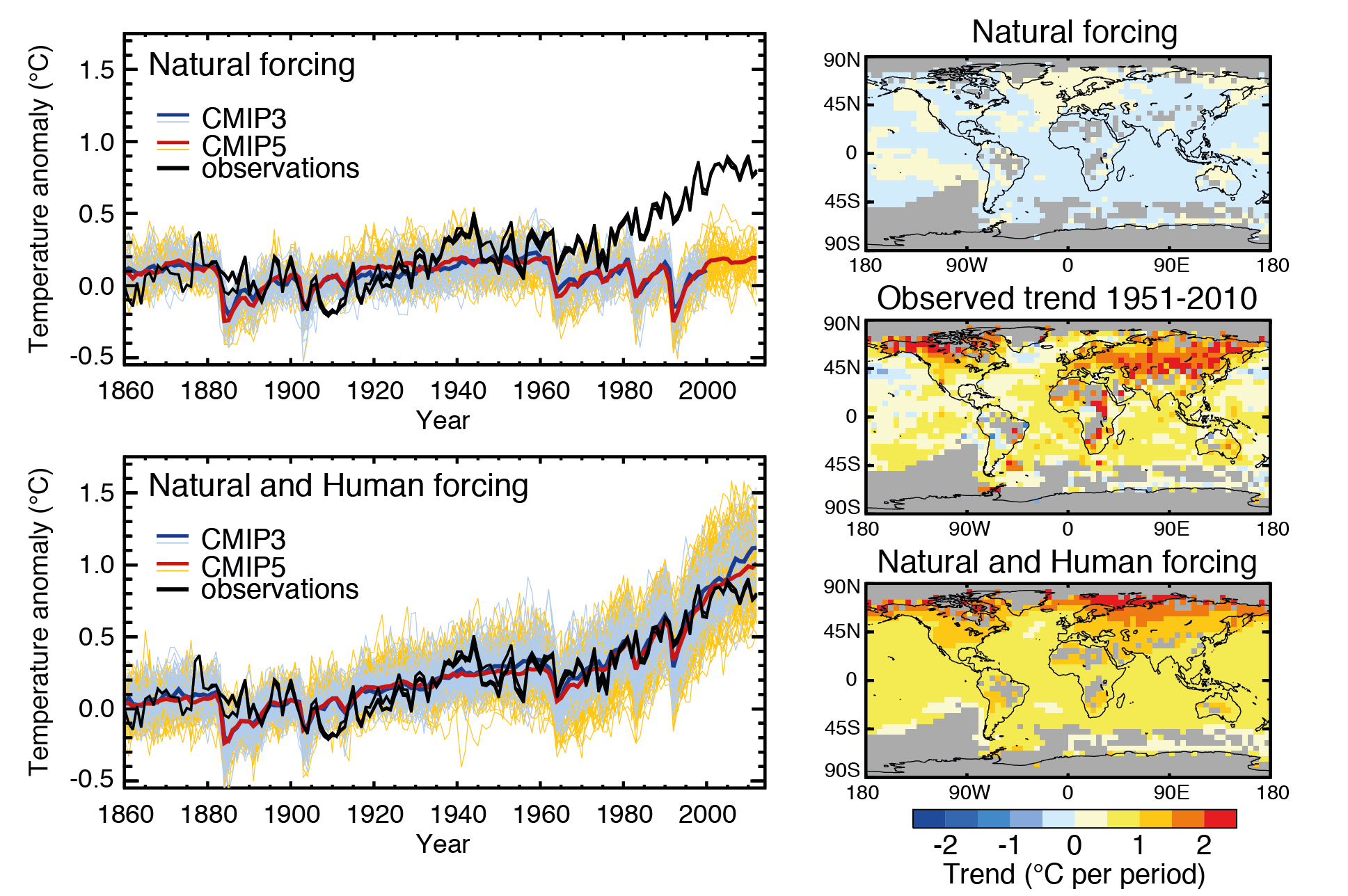
Source: IPCC

Research Scientist, University of Colorado, Boulder
It is accurate that the Earth’s climate has experienced natural variability including warm and cold phases. However, the crux is that these changes have NOT happened with human populations at a level even remotely approaching today’s population and development levels. The world population reached 1 billion in ~1800 (link) and climate within the 1000-800 years-before-present timescale was quite stable. Human populations, economies, infrastructure, development have formed during a period of climate stability.
The Little Ice Age ended as recently as 1850. Therefore, it is no surprise that we now are experiencing a period of warming

Professor, University of East Anglia, and Director of Research, Climatic Research Unit
The current period of warming is not because the Little Ice Age ended by 1850. Climate scientists study the causes of warming and cooling period and calculate their effects on our climate. These studies show that natural warming after the Little Ice Age was complete by the late 1800s. The warming from the late 1800s to the present is all due to human-caused climate change, because natural factors have changed little since then and even would have caused a slight cooling over the last 70 years rather than the warming we have observed.
See Figures 3b and 6c of Tett et al (2007)1 for example.
- 1-Tett et al (2007) The impact of natural and anthropogenic forcings on climate and hydrology since 1550, Climate Dynamics
Only very few peer-reviewed papers even go so far as to say that recent warming is chiefly anthropogenic.

Professor, Sr. Research, Oregon State University
This is a gross untruth. Most papers on climate change do not state that recent warming is chiefly anthropogenic because the anthropogenic driver is noncontroversial. Most papers are trying to document how fast change is happening and how it compares to model expectations for fossil-fuel driven global warming.

Research Scientist, University of Colorado, Boulder
As noted, this is false. The role of humans is well established, and has been for a number of decades. An example of what the climate would look like without anthropogenic forcing is available in this IPCC figure.
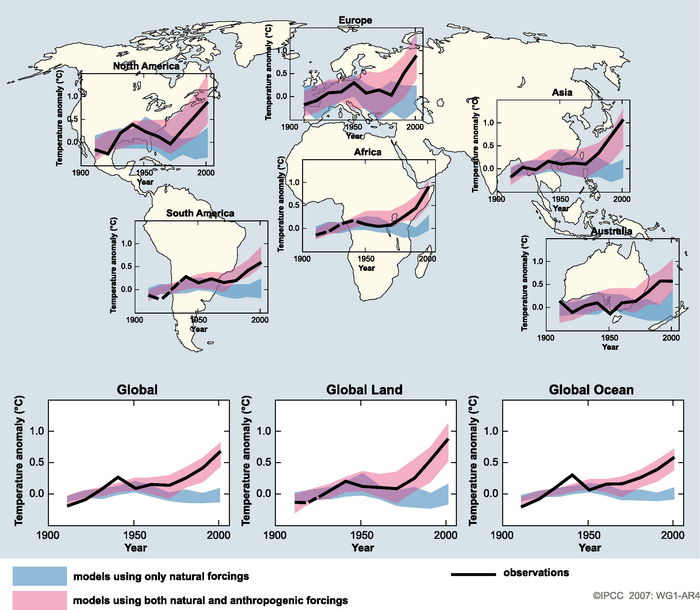
Source: IPCC
Warming is far slower than predicted. The world has warmed at less than half the originally-predicted rate, and at less than half the rate to be expected on the basis of net anthropogenic forcing and radiative imbalance.

Professor, University of East Anglia, and Director of Research, Climatic Research Unit
This statement is at odds with comparisons between the warming we have observed and the warming predicted by climate models. These comparisons show good agreement and do not support the claim that warming is far slower than predicted. That the authors of this statement do not know about these published model-data comparisons has led them to make these false statements.
For an example of the agreement between observed and predicted warming, see Fig. 4b of Cowtan et al (2015)1
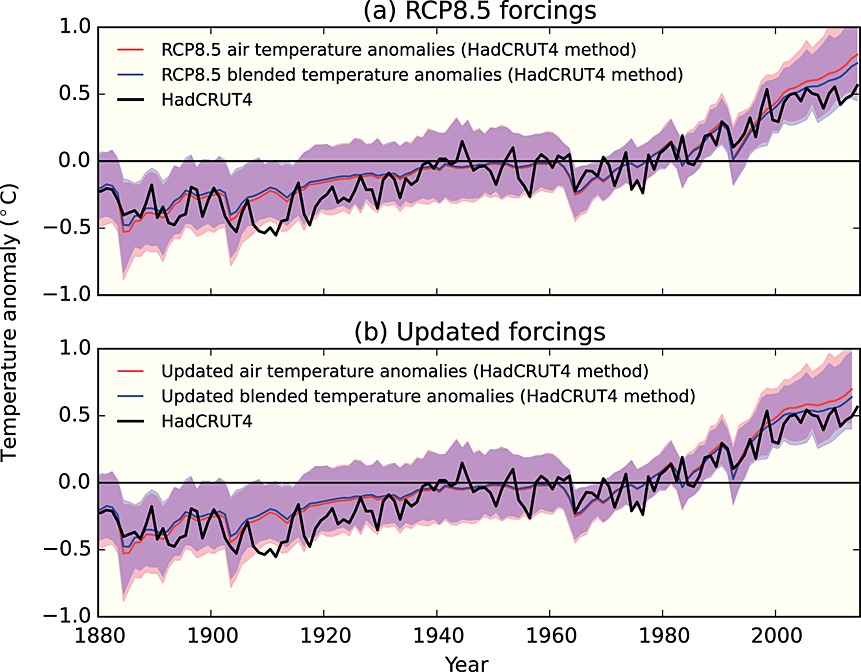
- 1-Cowtan et al (2015) Robust comparison of climate models with observations using blended land air and ocean sea surface temperatures, Geophysical Research Letters

Professor, Sr. Research, Oregon State University
The rate is very similar to the projections made by Hansen et al (1988)1. For readers’ information, the largest uncertainty about how the climate will change is how humans will emit in the future.
- 1- Hansen et al (1988) Global climate changes as forecast by Goddard Institute for Space Studies three‐dimensional model, Journal of Geophysical Research-Atmospheres

Scientist, University of Bonn, Germany
The estimates for how much the world will warm due to a doubling of the concentration of carbon dioxide have hardly changed for decades.
we are far from understanding climate change

Research Scientist, University of Colorado, Boulder
In fact, the basic chemistry and physics of climate change and the greenhouse effect have been well understood for more than a century. Here are a few of those milestones:
1859 – John Tyndall discovers that some gases block infrared radiation. He suggests that changes in the concentration of the gases could bring climate change.
1896 – Svante Arrhenius publishes first calculation of global warming from human emissions of CO2: doubling the CO2 in the atmosphere would raise global temp some 5-6°C (9-11°F)
1897 – Thomas Chamberlin produces a model for global carbon exchange including feedbacks.
1938 – Guy Callendar argues that CO2 greenhouse global warming is underway, reviving interest in the question.
1960s – Charles Keeling accurately measures CO2 in the Earth’s atmosphere and detects an annual rise. The level is 315 ppm. Suki Manabe and Richard Wetherald make a convincing calculation that doubling CO2 would raise world temperatures a couple of degrees.
1977 – Scientific opinion tends to converge on global warming, not cooling, as the chief climate risk in the next century.
In addition, [climate models] ignore the fact that enriching the atmosphere with CO2 is beneficial

Professor, University of East Anglia, and Director of Research, Climatic Research Unit
This statement is wrong: climate models do include the carbon cycle, too (they are then called Earth system models) and these include the effects of increased atmospheric CO2 on vegetation. That the authors of this report do not even know that these effects are included in climate models illustrates how little they really know about climate science.
For evidence that CO2 influences are indeed included in IPCC science and projections see e.g. Box 6.4 (“many models now have an interactive carbon cycle”) and Box 6.3 (“The Carbon Dioxide Fertilisation Effect… Elevated atmospheric CO2 concentrations lead to higher leaf photosynthesis and reduced canopy transpiration, which in turn lead to increased plant water use efficiency and reduced fluxes of surface latent heat. The increase in leaf photosynthesis with rising CO2, the so-called CO2 fertilisation effect, plays a dominant role in terrestrial biogeochemical models…”) of IPCC’s Fifth Assessment Report1.
- 1-IPCC (2013) Climate Change 2013: The Physical Science Basis

Professor, Sr. Research, Oregon State University
CO2 can be beneficial where plants are water stressed, by preventing loss of water, and in places that are now too cold for growth, like the Arctic.
Unfortunately the changes in temperature and water cycle globally will have far more negative effects.
CO2 is not a pollutant.

Professor, University of East Anglia, and Director of Research, Climatic Research Unit
This is only true for a narrow definition of a pollutant. If a pollutant is something that causes adverse effects on natural and human systems, then CO2 is a pollutant when it is increased rapidly in the Earth’s atmosphere and increases the risks of damaging effects.
See here for an explanation.
The more important note is that CO2 is a greenhouse gas. Thus, it is able to change the atmosphere’s ability to absorb solar radiation and increase temperatures.
[CO2] is essential to all life on Earth.

Scientist, University of Bonn, Germany
Nutrients are also essential for life. A farmer can still over-dung their fields. Too much nutrients cause algae blooms and is a major reason for biodiversity losses.
The natural CO2 concentration and its natural greenhouse effect are great for life on Earth and keeps the Earth at a pleasant temperature. That does not mean that increasing the CO2 concentration is a good thing.
To conclude, this argument makes no sense.
More CO2 is beneficial for nature, greening the Earth: additional CO2 in the air has promoted growth in global plant biomass. It is also good for agriculture, increasing the yields of crops worldwide

Assistant Professor, University of California Davis
This claim is misleading. In a meta-analysis of over 1,000 studies of the effects of climate change on agriculture[1], we find that, while CO2 is beneficial for crops, this effect rapidly decreases with increasing concentrations. The net effects of climate change on agriculture, including both the benefits of CO2 fertilization and the negative effects of warming, is negative for almost all regions. The effects of CO2 emissions on agriculture cost approximately $8.5 per ton, even accounting for the positive effects of CO2 fertilization.
- 1- Moore et al (2017) New science of climate change impacts on agriculture implies higher social cost of carbon, Nature

Researcher, Agricultural Sustainability Institute, University of California, Davis
CO2 is not a pollutant in the sense of being acutely toxic to life, but this framing is highly misleading. Water is also non-toxic and essential to life on Earth, but too much water in the wrong places can be devastating.
Natural ecosystems
The claim that “more CO2 is beneficial for nature” implies that the purpose of nature is simply to produce as much plant biomass as possible, a supposition that would be challenged by every ecologist I know. Dumping a limiting resource into a natural ecosystem is not something to celebrate. In that respect, adding CO2 to the atmosphere is somewhat similar in concept to adding nitrogen and phosphorus to waterways: it stimulates primary production, but it disrupts biogeochemical cycles and species relationships.
Although increasing CO2 does tend to stimulate terrestrial plant growth (if you ignore effects of CO2 on temperature and soil moisture), the stimulation is not necessarily a good thing for ecosystems as a whole. CO2 enrichment benefits some plant species while disadvantaging others (due to shifts in competitive dynamics, especially between C3 and C4 plants). Furthermore, plant biomass grown under high CO2 is less digestible, less nutritious, and slower to decompose. Changes in the quality and quantity of plant biomass also have hard-to-predict effects on animal populations, fungal and microbial activity, and soil composition. If only it were as simple as “greening the Earth,” but it’s not.
The only silver lining is that, because CO2 does tend to stimulate plant growth, carbon sequestration in plant biomass provides a negative feedback to our CO2 emissions. (This is already accounted for by many models.) But to say that plants help make our CO2 emissions slightly less harmful is not to say that we should be complacent about the emissions in the first place.
Agricultural ecosystems
Regarding “It is also good for agriculture, increasing the yields of crops worldwide”: There is some truth to this claim, but this description is dangerously oversimplified.
First, although controlled studies in the lab, greenhouse, and field do show that CO2 stimulates crop growth and yield, the effect diminishes after several weeks or months of CO2 treatment, once the individual plants acclimate. Many questions still remain about how the “CO2 acclimation effect” works in different species and under different conditions, but it is clear that extrapolating from short-term greenhouse experiments to long-term agricultural production is unwarranted.
Second, even aside from the CO2 acclimation effect, it is uncertain how much of the potential gain from CO2 fertilization would be realized in the real world—which not only has other limiting resources such as nitrogen and water, but which would also include higher average temperatures and more extreme events. This is why many scientists who model crop yield under future climate choose not to include the CO2 fertilization effect. (Some choose to report multiple model runs that both do and don’t include the CO2 effect.)
Third, and most importantly, the positive and negative effects of climate change on agriculture will not be felt equally around the world. Wealthy temperate regions will not see much harm, and may even see a net benefit, from warmer temperatures and increased CO2. But the opposite will be true of developing regions in the tropics, which do not stand to benefit from warming and will likely suffer from high temperatures and drought. Worldwide, the net effect might be very roughly neutral (probably slightly negative, depending on mitigation and adaptation efforts). But this is not a reason to be complacent, because those who stand to lose the most are also the most vulnerable.
In summary, regarding the European Climate Declaration’s claims on plant growth and agriculture, It is both scientifically and ethically indefensible for representatives from wealthy temperate countries to tell the rest of the world that there is nothing to worry about.

Professor, University of East Anglia, and Director of Research, Climatic Research Unit
This statement is based on selective misuse of evidence. There are benefits of CO2 for vegetation growth (though these benefits are often overstated) but these benefits will likely be limited by nutrient shortage and they may be overcome by changes in climate (e.g. increased drought) caused by the same increases in CO2.
For example, IPCC AR5 WGI Chapter 61 reported that “It is very likely… that nutrient shortage will limit the effect of rising atmospheric CO2 on future land carbon sinks”.
- 1-IPCC (2013) Climate Change 2013: The Physical Science Basis

Scientist, University of Bonn, Germany
More leaves is something completely different from beneficial for nature.
Unfortunately, the issue at hand is not isolated to additional CO2 in the atmosphere. Decision makers must address the full suite of changing that occur with climate change, including temperature and precipitation change, nutrient availability, etc. All crops will not respond the same to climate change, but overall global decreases in crop yield and reductions in food security are actually a major concern. This paper1 provides an example of research on the influence of climate change on crop yield.
1-Challinor et al (2014) A meta-analysis of crop yield under climate change and adaptation, Nature Climate Change
There is no statistical evidence that global warming is intensifying[…] floods
There is clear evidence that floods due to sea level rise have increased to the present, and are expected to increase more rapidly into the future. Details are available in the new IPCC Special Report on the Ocean and Cryosphere in a Changing Climate.
There is no statistical evidence that global warming is intensifying[…] droughts
There have been significant changes in drought, but it has included both increases and decreases.
“There is medium confidence that since the 1950s some regions of the world have experienced a trend to more intense and longer droughts, in particular in southern Europe and West Africa, but in some regions droughts have become less frequent, less intense, or shorter, for example, in central North America and northwestern Australia.”1
- 1-IPCC (2012) Managing the Risks of Extreme Events and Disasters to Advance Climate Change Adaptation
CO2-mitigation measures are as damaging as they are costly. For instance, wind turbines kill birds and insects, and palm-oil plantations destroy the biodiversity of the rainforests

Professor, Sr. Research, Oregon State University
An order of magnitude more birds have been killed by running into buildings and by cats than by wind turbines. This has been debunked for over a decade.
There is no climate emergency.

Professor, Sr. Research, Oregon State University
Temperature change of 0.2 deg C per decade since the 1970s is an emergency. If humans stop emitting CO2 now, it will take another 30 years or so for temperatures to equilibrate with the current atmospheric CO2.
We are already seeing significant negative effects, from sea level rise, to floods, to forced human migrations. The effects will only get worse unless we start investing significant effort to stop emitting fossil fuel CO2.
we will have ample time to reflect and adapt

Research Scientist, University of Colorado, Boulder
This is subjective. But given the scenarios under consideration by the IPCC, they do not suggest that a long delay in action can create the same future result as more immediate action. This can be seen by considering any of the projections that compare RCP2.6, RCP4.5, and RCP8.5.

